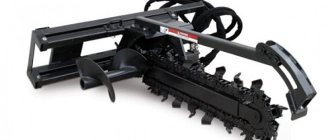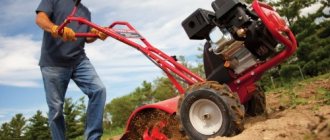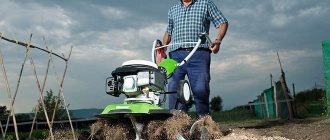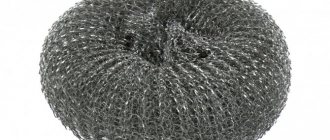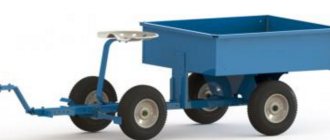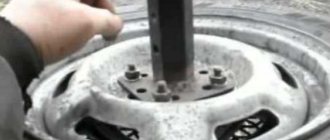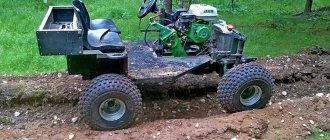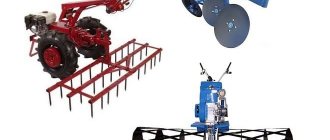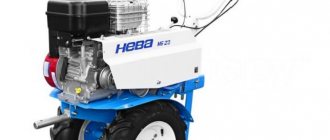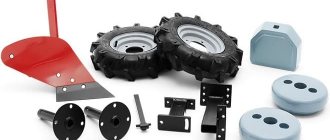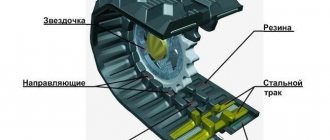A flat cutter (so called because the knives enter the ground parallel (flat) and cut everything in their path) is an excellent assistant in the garden and garden; it is designed for weeding both large and small areas of land. This attachment, consisting of a bracket on which two knives are located, is considered ideal for the destruction of weeds. Also, this device can create beds and holes, level them, and also penetrate deep enough into the soil. Basically, a flat cutter for a walk-behind tractor prepares the soil for sowing crops or already processes ready-grown bushes.
What functions does a flat cutter for a walk-behind tractor have?
With it you can:
- weed beds and garden plots;
- thin out and hill up the planting;
- create your own beds;
- fill the holes;
- level the soil;
- loosen the ground quite deeply, etc.
Previously, people used manual flat-cutters, but with the advent of walk-behind tractors and specialized attachments, the ability to perform the above-mentioned tasks with less physical effort and greater productivity became relevant.
Functions
The flat cutter for walk-behind tractors is very popular for a reason. Previously, gardeners used manual models, but when walk-behind tractors and attachments appeared, work in the garden became easier. Less effort was required and productivity increased.
Is used for:
- thinning plantings;
- hilling;
- weeding;
- ground leveling;
- deep loosening;
- preparing beds for planting;
- saturation of the soil with oxygen;
- crust destruction after rain;
- filling holes;
- inter-row processing.
The flat cutter does not turn over the soil, so it retains as much nutrients and moisture as possible.
At the same time, many gardeners note only one drawback: models of different sizes are required, because each crop has its own width between the rows.
You can easily buy a factory-made, branded flat cutter for a walk-behind tractor. But you can make it yourself, and the unit will turn out no worse.
How to work correctly with a flat cutter for a walk-behind tractor?
- To loosen and weed the rows, point the blades to the left, flat on the soil;
- To get rid of tall weeds as efficiently as possible, you also need to point the blade to the left and lift it a little;
- To create the beds themselves, you need to turn the blades down, then the result will be excellent;
- To plant seeds and form ridges, the blades should be turned to the right, flat on the soil.
In principle, each owner is free to adapt the existing unit to individual requirements, as well as test its capabilities, so in this case experiments are encouraged.
How to create a flat cutter for a walk-behind tractor with your own hands?
If a person does not want to spend extra money on factory-made attachments, he can create a homemade addition using available parts and tools. Moreover, even a classic Fokina flat cutter is suitable for adapting to the features of walk-behind tractors. First, we should familiarize ourselves with the diagrams and drawings presented on our website.
Algorithm for creating a classic version for a walk-behind tractor:
- First, you need to heat a piece of metal on a blowtorch, which will later become the blade;
- Using an encryption machine, it is necessary to sharpen it into a knife;
- It is worth making certain holes for placement as attachments;
- Having attached the products to the drawings, you need to determine the places that will be bent;
- Having heated these very fragments with a blowtorch, we give the blade the desired shape (for this task you can use an adjustable wrench);
- Afterwards, the finished flat cutter must be cooled (preferably in water);
- Having attached the device, you can start working.
If the land owner believes that options like factory cutters may be more practical, he is free to follow further operations to create a more modernized type of the mentioned device:
- You should find a small diameter and short pipe;
- Then make several holes in it at equal distances;
- Afterwards, it is important to find 2 small rectangular sheets of steel, give them the required shape, sharpen and weld them together in the shape of a boomerang;
- The final step is to connect (also using a welding device) the “iron boomerang” to the pipe (base).
In principle, creating such simple “helpers” is not a difficult task, the main thing is to have the necessary tools, parts and desire.
Sharpening
You only need to sharpen from the outside. On the inside, it is enough to remove the burrs at the end of sharpening.
First, the workpiece is sharpened on a sharpening machine, and then finished using a whetstone or a fine file.
If you bought a flat cutter and did not make it, then you do not need to sharpen it on a sharpening machine. The new original flat cutter has been sharpened; in the future you will sharpen it as needed.
The bulk of the work is done. All we have to do is make a handle for it and learn how to use it correctly.
Flat cutter for walk-behind tractor
Today, the market for equipment for agronomists has been replenished with many new, very convenient devices.
It’s no secret that the “palm” in the competition of the best of the best belongs to walk-behind tractors, which are “universal soldiers” and are perfect for performing almost any task. Naturally, such versatility of these units is revealed thanks to the many pieces of attachments that allow both removing snow and plowing the ground. A flat cutter with a ripper for a walk-behind tractor is one of the most famous and widespread devices, so we will pay maximum attention to it today.
Learn how to create a flat cutter for a walk-behind tractor with your own hands
As the most accessible and simple method, you can consider the following maneuver: you need to measure a certain length of a long steel plate and sharpen it, thereby creating knife blades.
Tools for hand use are often sharpened on both sides, but flat cutters for walk-behind tractors do not need this. In this case, only one-sided processing will be sufficient. The sharpened plate must be attached to the brackets (supporting) attached to the walk-behind tractor's hitch. To prevent the resulting plate from sinking into the soil to too great a depth, special limiters are used.
Ordinary wheels from toy cars are suitable for this task, the main thing is to choose the right size. Moreover, in order to prevent these wheels from breaking during the first use, it is necessary to fill them with metal bushings in order to increase the level of durability. The resulting parts must be placed from below so that the tool blade is immersed in the ground no deeper than 5 cm.
An important point: if you don’t have a metal plate at hand, you can use the blade of a segment mower, first dividing it into 2 parts. But you cannot proceed without securing the resulting segments, otherwise the product will “run” from side to side and create discomfort for the operator.
To ensure that the immersion process occurs without much effort, it is advisable to weld a heavy part on top. After completing all operations, you need to take care of the coupling, which will become the connecting link with the body. To do this, it is necessary to attach a bearing to the inner side of the axle, on which a plate will be placed, which is the “base” for further screwing on a homemade plane cutter.
In order to get to know the specifics of the object in more detail, we present to your attention special drawings:
If a person wants to get clarification on all controversial issues, he can watch a video of the process itself and a demonstration of finished products:
As you can see, creating a high-quality flat cutter for a cultivator yourself is not so difficult; the main thing is to have the necessary parts and desire. It is also very pleasing that the created hitch is suitable for such walk-behind tractors as Neva, Salyut, Oka, Zorya, Centaur, etc. Therefore, you can safely use this lesson and see from your own experience that with a serious approach, even at home you can get a very worthy and useful part for a walk-behind tractor.
Star cultivator and flat cutter
The star cultivator is another device designed to control weeds. This product is sometimes called a disk or rotary product, because its main elements are star-shaped disks connected to each other. This weeder is usually equipped with wheels and a long handle for easier use.
In order for the manual star cultivator to start working, it needs to be placed on the bed and moved along it with a little effort. The sharpened discs will simultaneously loosen the soil and trim the roots of harmful plants. This operating principle allows you to use this weeder in the most inaccessible places.
A garden cultivator-flat cutter is a base on which cutting elements - knives - are attached. They are made from high-quality structural steels and are specially sharpened to protect the tool from rapid wear. The knives are designed in such a way that weeding can be done in both directions. They are quite thin, so they create virtually no resistance in the ground.
Figure 2. Assembling a cultivator with a wheel.
This greatly contributes to ease of operation. The ability to change cutting tools significantly expands the range of applications of a flat cutter.
This product is used for the following work:
- dumpless loosening of soil at a significant depth;
- effective weeding by cutting their roots;
- harrowing the surface layer of soil;
- cutting furrows before planting small-seeded crops (lettuce, dill, radishes, etc.).
DIY flat cutter for walk-behind tractor
In recent years, many land owners are increasingly using new technical developments that can make life much easier and spend much less time on certain tasks.
Walk-behind tractors, cultivators, mini-tractors and other devices have a tangible impact on the life of an agronomist. If traditional hoes were previously popular, which forced them to cultivate heavy soil in a half-bent state for several hours, today they have been replaced by innovative flat cutters designed for operation together with a walk-behind tractor.
Flat cutters for a walk-behind tractor: advantages and disadvantages of using the device
Flat cutters can be safely called a kind of hybrid of a harrow and a knife. They are mounted parallel to the ground or at a slight angle. As a result, the device sinks into the soil to a shallow depth and cuts off the roots of weeds, thereby turning the soil itself, promoting better preservation of moisture and nutrients.
In addition to the above positive aspects, flat cutters:
- improve soil condition;
- destroy crusts and lumps formed after heavy rain;
- repel pests;
- prepare the soil for long-distance planting;
- perform inter-row cultivation of crops;
- saturate the top layer with oxygen.
Naturally, in some cases, owners purchase flat-cutters with a ripper for a walk-behind tractor, which not only perform the mentioned tasks, but also remove excess load from a person, are easy to operate, do not require lifting, and are characterized by excellent productivity. Such devices often have a fairly affordable price, but some craftsmen manage to create flat-cutting rippers for walk-behind tractors with their own hands.
WHAT IS A WEEDER AND WHY IS IT NEEDED?
A weeder, also known as a frame flat cutter, is an agricultural tool used for weeding, loosening soil, fluffing up rows, etc. Several types of hand weeders and special attachments for motor cultivators are common in agriculture:
- Weeder "Swift".
- Fokina flat cutter.
- Weeding "razor".
- Weeding pads for motor cultivators.
PRINCIPLE OF USING THE TOOL
Let's start with a word of caution: weeders are NOT used as a hoe! This is fundamentally wrong. His task is to trim the top layer of soil 1.5 - 3 cm, the resulting crust and young weeds. This is both weeding and loosening, which is very useful for plants.
Various types of weed weeds
Desirable rules for working with weeder:
- Work with young weeds. Don't delay or grow pests higher than the corn. Then even a shovel won’t help – the vegetables won’t be of any use.
- Adjust to row spacing. Standard row spacing is processed in one or two movements.
- When working with a tool, pull it towards you or push it away from you. Tilt the handle and make sure that the blade goes 1-2 cm deep into the soil. In one motion, cut a strip of soil 50-80 cm.
- Work on bare soil.
- After rain, loosen the slightly dry (0.5 - 1 cm) soil.
Do-it-yourself flat cutter for a walk-behind tractor: a simple manufacturing method
If the walk-behind tractor has quite impressive characteristics, it is advisable to make several flat cutters and place them on the device. Thus, you will get an even more productive unit that will not only save time, but also energy.
For excellent maneuverability of the created flat cutter, you need to take care of the appropriate wheels. Almost any materials are suitable for them. An iron tube would be an excellent choice for an axle.
Then, it is advisable to weld two circles on both sides of the concrete cutting. According to the diameter, you need to attach several wires (using a welding machine), the diameter of which does not exceed 8 mm.
On the inside of the axle, it is necessary to leave space for placing the bearing and further installation of a homemade plane cutter. Since the walk-behind tractor body is not always made of very durable material, the main emphasis is on the axle. After the bearing is attached, a plate should be welded to it.
Flat cutter blades can be created from separated mower parts. Their lightness and compactness make them ideal cutting element components. It is important to make sure that they are securely fastened, otherwise the structure will move from side to side and will not perform its task efficiently.
To limit the depth of immersion, small wheels are often used. A standard children's car can be an excellent “donor”.
The wheels themselves can be supplemented with iron parts so that the plastic does not deteriorate while driving. The immersion depth must be at least 5 cm.
To increase the weight on the flat cutter for the cultivator and increase the pressure for entering the soil, you can weld a weighting agent in the form of any part. If the necessary components are missing, you can use a basket of bricks, but such a solution is not convenient.
For a better understanding of the design features, it is suggested that you familiarize yourself with the drawings. The presented videos can also serve as a guide, because on these materials many craftsmen share their experience with users and reveal the secrets of creating truly durable and reliable attachments for walk-behind tractors.
It is worth noting that the created flat cutter is suitable for both Neva walk-behind tractors and equipment from the brands Centaur, Salyut and others. The versatility of the product allows you to create a truly excellent assistant at home and without any special financial costs!
Homemade attachments for walk-behind tractors
For medium and high power walk-behind tractors today, suppliers and manufacturers offer a huge amount of attachments and accessories that provide mechanization of many operations. However, despite such attractive offers and ready-made options for supplying kits, many owners prefer to make attachments for the walk-behind tractor with their own hands. And the reason is not that homemade ones are cheaper. Not at all, if we take the cost of materials, then this is absolutely not true. The problem lies elsewhere. Do-it-yourself tools for a walk-behind tractor are, for the most part, tools that are universally selected according to their quality parameters and meet the needs of a specific person.
This approach to the formation of a fleet of agricultural machinery makes it possible to take into account in the process of designing and assembling equipment all possible features of both the site and the owner himself.
The equipment being developed for the unit is conventionally divided into equipment:
- universal purpose;
- highly specialized focus;
- auxiliary equipment and devices to simplify the control of the walk-behind tractor.
Universal tools include, first of all, adapters and various types of trailers, which make the walk-behind tractor a universal transport platform both for transporting goods and as a convenient vehicle. Some models of walk-behind tractors are capable of reaching speeds of up to 25 km per hour. Although the comfort of a mini tractor is still far away here, you no longer have to walk.
Highly specialized types of equipment are most often designed to perform only 1 or a maximum of 2 operations. However, these are the tools that are most in demand in terms of consumer qualities for high-quality soil cultivation, performing operations to care for crops, harvesting feed, and even used in construction. In part, it should be noted that among special-purpose homemade products, relatively simple types of tools predominate - plows, cutters, hillers. This is something that can be done from scrap materials and using the simplest power tools. But more complex elements are manufactured using units from other equipment.
And, of course, what makes it easier to control is a counterweight on the walk-behind tractor, wheel weights and anti-slip chains - all this allows you to work with the unit all year round.
Tillage tools - do-it-yourself plow and plow for a walk-behind tractor
Before attaching a walk-behind tractor to tillage, you should decide what is more important and set priorities in terms of technology for cultivating the site. For large areas used for planting potatoes, root crops, and grain crops, the optimal option would be a plow for a walk-behind tractor
with your own hands. Make it simpler and easier. But for beds for vegetable crops, for processing strips between rows of the garden or final processing for planting, it is better to use a milling cutter. This will make further work much easier.
When the coupling to the walk-behind tractor is ready, the most difficult thing in making the plow is its shape. The body has a shape that is difficult to mold and therefore it is better to make a plow from several components. It is better to make a coulter for a walk-behind tractor with your own hands from steel. The large force that this element will experience should not lead to its deformation. Moreover, it is the coulter that is responsible for the depth of lowering of the plow.
The plowshare should be made of the hardest possible metal. This is the part of the plow that cuts into the ground and cuts its layer. The strength and power of this element will allow you to work with the plow both in the conditions of cultivated arable land and to do preliminary processing of virgin soil. Despite the complexity of the blade design, it is quite simple to make. For a curved blade, it is better to take a ready-made round or oval-shaped workpiece. Make a dump out of it according to the drawing. For this, craftsmen usually use large pipes of 350 mm in diameter or gas cylinders. This results in an almost ideal blade shape.
One of the questions on how to make a plow for a walk-behind tractor will be the manufacture of a field board - a stabilizing element for the plow, which sets the direction of its movement when working on arable land.
A do-it-yourself plow for a walk-behind tractor, just like a plow, is assembled from several elements. True, to use a plow in soil cultivation, it is better to provide a blade made of reinforcement, so that during cultivation the soil is loosened as much as possible when the formation is turned. In the design of the plow, it is better to provide not a frontal blade, but a double-sided blade with reinforcing bars.
Disc cultivator for walk-behind tractor
One of the most popular types of attachments for a walk-behind tractor during the summer plant care period is a cultivator. You can make a weeder for a walk-behind tractor with your own hands:
- following the example of a classic cultivator in the form of a trailed ripper;
- in the form of disk hillers used for processing root crops.
The processing technology involves passing a walk-behind tractor between two rows of crops or when using a multi-hull cultivator of three or even four rows.
The hiller ripper can have several types of tools installed in one housing:
- ripper;
- two double-moldboard flat-cutting plows;
- 2 disc harrows for forming beds;
- two disks for plant protection.
Do-it-yourself plant protection discs for walk-behind tractors are usually made of sheet steel. Depending on the purpose of the device to which they will be applied, their diameter is calculated. For cutters, the diameter is usually 5-7 cm smaller than the cutters, and for a cultivator they should be 30-35 cm in diameter. It’s just that when milling an area, the plants usually have a small height. But cultivation is carried out when the plants reach significant growth, and their breakdown at this stage can result in the death of the vegetable crop.
DIY flat cutter for walk-behind tractor
Auto mechanic, specializes in agricultural equipment
A flat cutter (so called because the knives enter the ground parallel (flat) and cut everything in their path) is an excellent assistant in the garden and garden; it is designed for weeding both large and small areas of land. This attachment, consisting of a bracket on which two knives are located, is considered ideal for the destruction of weeds. Also, this device can create beds and holes, level them, and also penetrate deep enough into the soil. Basically, a flat cutter for a walk-behind tractor prepares the soil for sowing crops or already processes ready-grown bushes.
How suitable is the cultivator for frequent weeding?
If you have a small summer cottage, you won’t need powerful equipment for cultivating the land. For example, if you have several beds and a greenhouse, it is enough to take a light unit, but to loosen the soil on a couple of acres, you will need a medium to heavy cultivator. In any case, if you take the first mechanism you come across, you will almost certainly only have cutters at your disposal. Attachments are produced not only for walk-behind tractors, but also for cultivators, but not for all models. Therefore, try to first watch video presentations of various manufacturers of garden equipment.
Today you can buy a gasoline or electric cultivator, the first is heavier, and the exhaust pollutes the air considerably, the second is more environmentally friendly, but is not autonomous - you need to pull a cable behind it.
In most cases, you have to make attachments for garden equipment yourself, or remake cheap homemade models. The easiest way is to make a flat cutter, which is a long transversely oriented strip of metal, sharpened along the leading edge. But such a device is not suitable for processing beds; it is more convenient for them to work on a flat surface. Therefore, weeding between rows with a heavy motor-cultivator is often done with an adapted disc harrow, which quite successfully copes with cutting the roots of weeds.
Also, before the emergence of seedlings, and often before hilling the garden, a mesh harrow is suitable. It can be used with both a cultivator and a walk-behind tractor. Depending on how heavy the draft mechanism is used, you need to calculate the appropriate number of links and, accordingly, teeth. This is necessary so that the resistance to forward movement due to the immersion of the rods in the ground does not exceed the power of the unit. The technique of working with attachments can be seen in numerous video recordings.
Features of flat cutters of a walk-behind tractor
This device has the following operating principle:
- first, the knives carefully penetrate into the soil;
- then the walk-behind tractor begins to move, prune and thereby destroy the root systems of unwanted plants.
When this plant is already cut, it remains in the ground, rots there and subsequently becomes an excellent fertilizer for the soil.
A huge advantage of a walk-behind tractor is that when working in the ground, this device does not destroy or mix the upper crust of the earth, thus not only leaving the structure of the soil, but also improving it. Another plus is that the flat cutter prepares the ground for planting plant seeds and makes the necessary holes.
In this video we will look at a flat cutter for a walk-behind tractor:
Types of flat cutters for walk-behind tractors
There are several popular types of flat cutters. Each of them has its own characteristics and differences.
Maznev “PM-4” flat cutter
It has the most optimal and suitable design for cultivating and loosening the earth. This model has modified fastenings and narrowing of the blades themselves, which can change the distances between the “whiskers” of fastening the knives (this can be moved, changing the length from 10 to 20 cm), so that different areas of the ground can be processed.
It has a small, round handle, a “heel”, which helps maintain the optimal depth of penetration of the knives into the ground and the special arrangement of the angles of inclination of the device. This device easily penetrates the ground, destroys all kinds of weeds and saturates the ground with a sufficient amount of air, but it does not cope with hilling the ground.
TYPES AND FEATURES OF HAND WEEDERS AND NOZZLES
Weeders, like other agricultural implements, are produced by different factories under different brands. But it is worth saying that they differ not only in names, but also in some design features.
POLISHNIK "SWIFT"
This agricultural tool is made in the form of a metal bracket, which is evenly sharpened on both sides. Thanks to this design, it easily cuts off a thin layer of soil and leaves it in place, maintaining the structure of the soil.
The hardened steel from which the tool is made requires virtually no sharpening. It is not recommended to use it on clogged soils and virgin lands - it is ineffective. But for getting rid of young weeds, it will come in handy.
FOKINA FLAT CUTTER
This instrument has an interesting history. V.V. Fokin invented and designed it after suffering a severe heart attack - working with a shovel was contraindicated for him.
And, instead of giving up his beloved gardening, he made life easier for himself and many other summer residents. The flat cutter looks like a metal bracket, but can replace almost all gardening tools.
Fokina flat cutter
It weighs very little. With a flat cutter you can loosen, fluff up, trim, hem, break the ground, rake and form ridges, thin out... This is a truly universal tool.
Single-row motoblock hiller
This attachment is the most convenient and in demand among buyers. Using a simple but reliable design, you can hill up various cultivated plants and independently adjust the size of the bed. Also, a single-row flat cutter for a walk-behind tractor can be used to cultivate relatively small areas of land with average soil without much difficulty, and also to control weeds, fill the soil with the necessary amount of oxygen, and create even beds with the necessary parameters.
Important! This equipment has a thermally reinforced edge of the main element, which is what makes it more resistant to natural conditions and prolongs the life of this hiller.
Store-bought or homemade
One of the main assistants for a gardener in the garden is a walk-behind tractor. It is with the help of it that you can easily do loosening, weeding, and plowing. But to expand the functionality of the unit, they use a flat cutter, which also helps get rid of weeds.
The answer to the question of whether to buy a flat cutter or make it yourself largely depends on whether you are willing to spend time and additional parts.
What kind of flat cutters for walk-behind tractors do you use?
PurchasedHomemade
What you need to pay attention to when making a flat cutter yourself:
- Material . It is best to take steel. It does not rust and lasts longer.
- Form . In any case, by omitting the parts, the flat cutter will resemble a comb.
If you decide to buy a flat cutter, then the main attention is paid to the price and model of your walk-behind tractor. Besides:
- immersion depth;
- tilt angle;
- material.
Double-row hiller for walk-behind tractor
This type of hiller differs in content (equipment), appearance, power, and functions. A two-row attachment for a motor cultivator is better because it can help you hill up large areas of soil faster and less expensively, and you can also work with it in any weather and even with heavy soil.
It helps with clearing the area of weeds, leveling the soil or the bush of a cultivated plant, filling the black soil with a sufficient amount of moisture and oxygen, and preventing the sun’s rays from damaging the plant.
Necessary materials
In order to be able to independently produce various types of products useful for cultivating the garden, it is advisable to have the most necessary and frequently used materials on hand. Materials that should be in any workshop are, first of all, steel.
The more profiles, strips, rods and steel pipes there are on the farm, the easier it will be to carry out various works, carry out repairs and produce useful equipment.
Also, you definitely need a welding machine, with which you can quickly and reliably connect all metal parts.
This can also be done using metal screws, but their scope of application and reliability are not comparable to welding.

